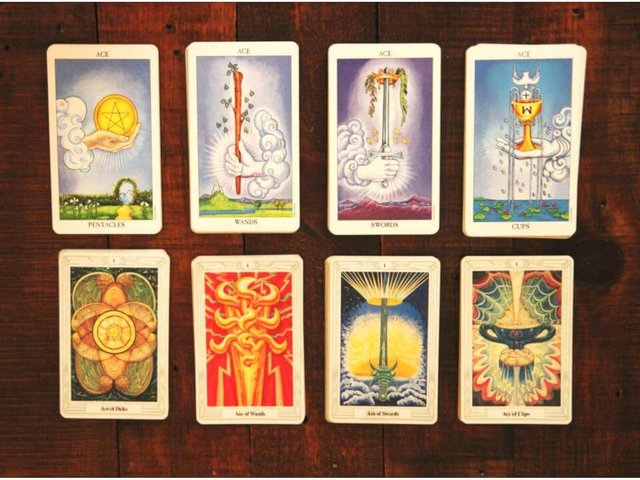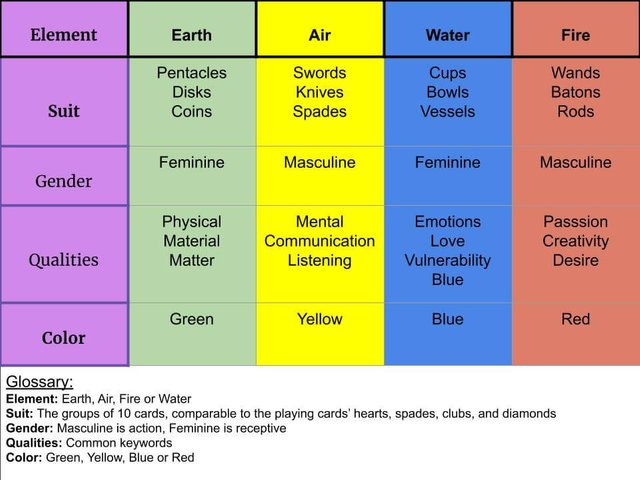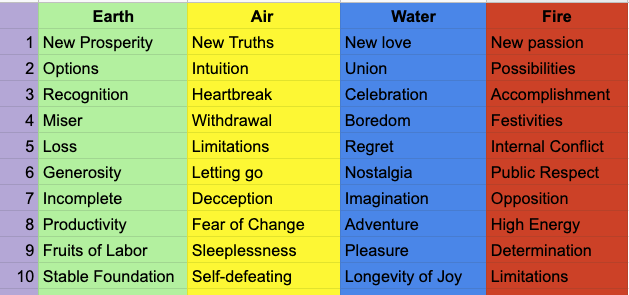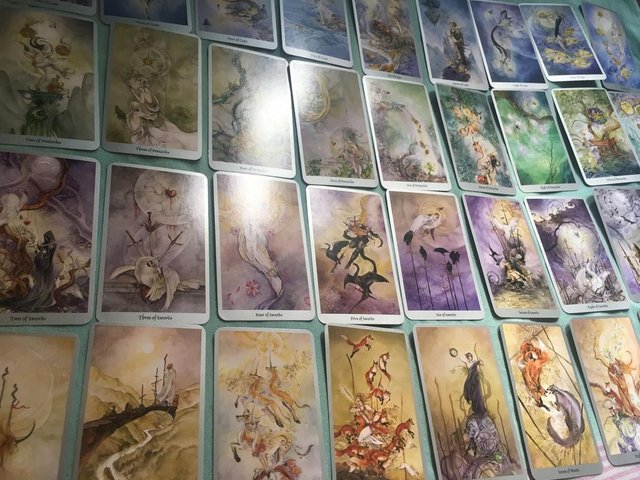Tarot Wyzdom with Love: The Pippin' Cards #6/10
All that you have, feel, desire, and think are depicted in the grouping of tarot cards known as the Pip cards.
These 40 cards contain all the details of how the archetypes presented in the Major Arcana play out.

If we have already lost you then please visit Tarot Wyzdom with Love: Making Sense of The Major Arcana
Day to day routines and activities as well as challenges and obstacles of mortal life are depicted in this section of the tarot, commonly referred to as the Pip cards. Through the use of the basic elements of life, numerology, and symbolism these cards depict the ups and downs, ins and outs, joys and sorrows, and the highs and lows of mundane life.
The Pip cards are the final group of the three main groups always found in the tarot. These tarot groups were first presented in an earlier blog, Tarot Wyzdom with Love: How to Dissect the Tarot Cards. Visit this blog for more information about the tarot groups.
Before we dive in it’s important to address that you have a good tarot deck for genuine study.
If you don’t know what a good tarot deck is then, go ahead and click over to our second post in this series. These articles are specially designed to quickly get you using your cards like a pro.
9 Important Things to Know for Choosing and Cleaning Your First Tarot Deck
If you missed the first post in this series,
7 Steps in 30 Minutes or Less to Learn the Tarot Cards,
, here is the link to get you caught up.The third article is
Tarot Wyzdom with Love: How to Dissect the Tarot Cards
. Great basic stuff!The fourth article in this series is 4 Easy Steps to Conquering the Court Cards.
The fifth and last, up to this point is Tarot Wyzdom with Love: Making Sense of The Major Arcana
These articles all build on each other or can be used as a stand-alone to address specific topics.
This is the sixth lesson in my series of 10 articles to get you easily and simply using your tarot cards.
The Pip cards are composed of:
- elements
- symbols
- numbers
- Depictions of the processes of mundane life.
Below are charts to help simplify these aspects.
Study these charts for gaining understanding. Use the Basic Study activity below to gain a deeper understanding.

The photo above shows the Aces for all 4 elements representing each of the 4 suits found in the tarot cards. The top row is a Rider-Waite version while the bottom row is the Thoth version.
As mentioned in earlier lessons, these are the top 2 all-time, best-selling tarot decks since the day they came on the market. They are, basically, the parents of most all other tarot decks.
We advise, for the true tarot scholar, that you become very familiar with these two decks. Now, compare the similarities and differences in the Aces of these two decks.
Can you tell by looking only at the photo which element each is? Which suit?
There are no books to specifically explain these cards outlined in this lesson.
The truth is that
to really know the cards you must put them in your hands, sort them, use these charts, compare what you see in the actual card to what is written in the charts. There’s just no other way.
The Elemental Chart of the Pip Cards

Blending Aspects of the Elements and Numbers

As we discussed in previous lessons, Numerology is an important aspect of tarot. Every number has associations that are woven into the characteristics of each card.
Only the Court Cards do not heavily rely on Numerology.
Then, the Elements, as depicted in the first chart above, are dominating characteristics of the Pip Cards. The elements are defining principles of each of the four 10 card groupings.
The chart above, Blending Aspects of the Elements and Numbers, attempts to demonstrate defining keywords when the element and number are blended.
Element + Number = Keyword
For a clearer understanding, we recommend the activities listed below.
-----------------------------@@@@@----------------------------
ACTIVITIES:
Challenge yourself.
Using the photo below, see if you can identify the suits, gender, elements, etc. simply by looking at the photo and referencing the charts above. The cards in the photo are in numerical order 1 - 10.

Basic Study:
- Use the charts above to lay out your cards in the pattern of the charts.
- Compare the pictures, numbers, and symbols with the charts.
- Ask yourself how the aspects of the elements, numerology, gender, and so on are symbolized and expressed in the art of the card.
- Write it down or discuss what you see in a study group.
Tarot Charades:
Just like the name indicates, it’s a game of charades. You will need at least 2 people for this activity but the more people you have the more fun it is.
- Separate the Pip cards from the tarot deck.
- Shuffle them face down then put them together in a tidy stack.
- The first player pulls the top card without allowing the other players to see.
- Like traditional charades, silently act out the card until the others guess the card or you may choose to use a timer. Do not reveal the number of the card unless you want to make it easier. For example: If you hold up 3 fingers, indicating #3 then the card possibilities have been reduced to 4 options; 3 of Cups, 3 of Wands, 3 of Swords or 3 of Pentacles.
- Continue taking turns, pulling the top card, giving silent clues and guessing the card until you have used the whole deck or you just feel finished.
- If you want to keep score then give each correct guess 1 point.
Pip Stories:
This one is fun to do with random cards from a shuffled deck or put the cards in order by suit and number.
- Using a long table layout the cards one at a time in the fashion of a train, going from left to right.
- Either tell the story out loud as you see it or using your tarot journal, write the story.
- Create an imaginary character or pretend you are in the setting. What is the character doing? Going? Where has he been? 4. What are his thoughts? Feelings? Desires? Passions? Etc.,.
- If you get stuck, it’s okay to look up the card for keywords.
---------------------------@@@@@-------------------------
Clicking through these links and/or making any purchase
through them supports Love and
continuing the Epic Journey.

Curious about the deck above?
It is the The Shadowscapes Tarot Cards deck. Click to take a closer look. It is a very beautiful deck by one of our favorite deck creators, Barbara Moore.
Although there are no specific book resources for the pip cards we recommend these great books for more activities and ways to get to know your cards.
Another fun activity book we highly recommend is The Tarot Coloring Book. Coloring in the cards is a great way to familiarize yourself with every detail of every card. Make yours with your own original colors or attempt to replicate the cards exactly the same as Rider-Waite.
When approaching the tarot cards from a scholar’s perspective it is a good idea to have some quality reference material on hand. We encourage you to grow a good library to have on hand while going through these basic lessons as well as the more vast Tarot Course study which is to follow the 10 lessons.
Recommended topics to begin stocking your library for deeper research of the tarot are: Numerology, Astrology, sacred geometry, kabbalah, and the Hebrew alphabet.
The list of books we would suggest is pretty extensive so, a few to get you started are:
- Numerology and the Divine Triangle by Faith Javane This is a relatively old book but is a classic.
- Numerology: With Tantra, Ayurveda, and Astrology by Harish Johari
- Tarot and Astrology: Enhance Your Readings With the Wisdom of the Zodiac by Corrine Kenner
- The Complete Magician's Tables by Stephen Skinner. Full of great tables and charts for defining many, many aspects of the tarot.
- Kabbalistic Tarot: Hebraic Wisdom in the Major and Minor Arcana by Dovid Krofchow This is one of our favorite resources for addressing the Tree of Life and Hebrew Alphabet associations of the tarot. The author does a great job of simplifying an otherwise complex topic.
There are many great books on the market to further explore tarot journaling - a few that we recommend are:
- The Simple Tarot Journal: A Personal Tarot Handbook by Angie Green
- Tarot Journaling: Using the Celtic Cross to Unveil Your Hidden Story by Corrine Kenner
- Your Personal Tarot Journal: An Intuitive Journey by CC Sullivan
There are countless great books on the tarot cards but few focus solely on the Major Arcana. However, there are a few we believe you might want to own:
- Exploring the Major Arcana: A Workbook for Empowerment by Judyth Suit
- Kabbalistic Tarot: Hebraic Wisdom in the Major and Minor Arcana by Dovid Krafchow. I love this book’s easy approach to understanding the major arcana through the Hebrew alphabet and the Kaballah.
- The Major Arcana Coloring Book by Ashley Fern: 22 beautiful and intricate designs of the ancient tarot illustrated by Ashley Fern by Ms. Ashley Fern
Now that you are familiar with some basics we encourage you to explore even deeper. All the court cards additionally, have astrological associations. If you have an interest or background in astrology this might be a great path for your personal study.
- Tarot and Astrology: Enhance Your Readings With the Wisdom of the Zodiac by Corrine Kenner
- Tarot and Astrology: The Pursuit of Destiny by Muriel Bruce Hasbrouck
In addition, Carl Jung
explored archetypes and as a result, he has left a great legacy of written work on comparing the Court cards to Jung's archetypes. This is a wonderful direction of study for those interested in psychology.Suggested further research and resources list:
clicking through these links and/or making any purchase
through them supports building a more loving world and
continuing the Epic Journey.
Suggested Beginner Books
- Tarot for Beginners: A Holistic Guide to Using the Tarot for Personal Growth and Self Development by Meg Hayertz
- How to Read Tarot: A Modern Guide by Jessica
- The Ultimate Guide to the Rider Waite Tarot by Johannes Fiebig
Book List for Study of the Court Cards
- Understanding the Tarot Court by Mary K Greer
- Tarot Court Cards for Beginners: Bring Clarity to Your Readings by Leeza Robertson
- Your Tarot Court: Read Any Deck With Confidence
Upcoming Tarot Course Study Materials
- Universal Waite Tarot
- Seventy-Eight Degrees of Wisdom: A Tarot Journey to Self-Awareness (A New Edition of the Tarot Classic) by Rachel Pollack
- Thoth Tarot Deckby Aleister Croweley
- The Tarot Handbook: Practical Applications of Ancient Visual Symbols by Angeles Arrien
As always,
Love is available
for a variety of tarot readings to support you in creating the future you desire.
Tarot Wyzdom with Love
is now taking appointments
--------------------------@@@@@-------------------------
In the next article of this series we are digressing a bit.
Get ready for your first exam.
A test of your knowledge will be the focus of the next blog in this series, covering lessons 1 - 5.

Remember to Share the love with Love
UpVote
Comment
Repost
